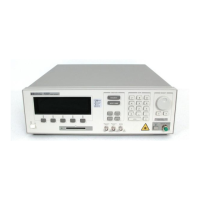2
Press
4
WAVELENGTH
5
and
NNNNNNNNNNNNNNNNNNNN
nm/GHz
as necessary to get this display.
See \Changing the Value of a Parameter" in Chapter 1 if you need details on
how to edit parameters.
Example
To set the wavelength to 1505.500nm (on an HP 8168E/F)
1. Press
4
WAVELENGTH
5
2.
Press
NNNNNNNNNNNNNNNNNNNN
nm/GHz
, if necessary, until the display looks as shown
in Figure 2-2
3. Type in 1505.5 on the numeric keypad, and press
4
ENTER
5
.
Setting a Relative Wavelength
You use a relative wavelength for heterodyning, for example, when you are
measuring the linewidth of DFB (distributed feedback) lasers.
You can set a relative wavelength if the display looks like this:
Figure 2-3. Setting a Relative Wavelength
Press
4
WAVELENGTH
5
and
NNNNNNNNNNNNNNNNNNNN
nm/GHz
as necessary to get to this display.
The output wavelength (
) is set from the base wavelength (
0
) and the
frequency oset (df). The formula for calculating the output wavelength is:
=
c
(
0
)
df
+
c
0
where c is the speed of light in a vacuum (2.998
2
10
8
ms
-1
).
You can edit only the value of
df
directly. See \Changing the Value of a
Parameter" in Chapter 1 if you need details on how to edit parameters.
Changing the Base Wavelength
If you want to change
0
,
1. set
to the value to which you want to set the base wavelength (by
calculating
df
, or by setting the wavelength directly) and then
Setting Wavelength and Power 2-3

